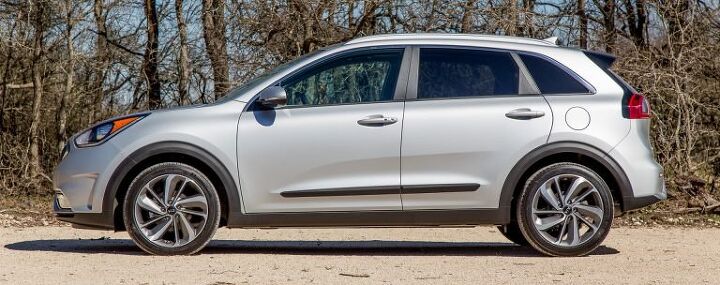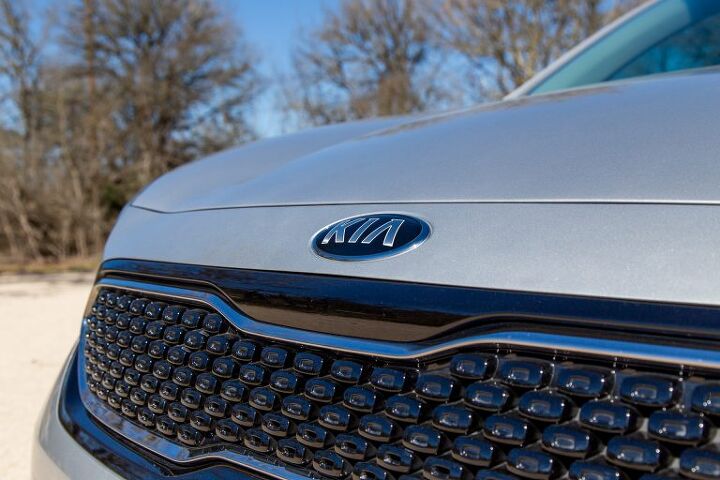2017 Kia Niro Hybrid First Drive Review - Hold the Trimmings

2017 Kia Niro Hybrid
Remember MTV? Back on September 18, 1983, the once-music-oriented television station — before its foray into an endless stream of mindless reality programming — broadcast a momentous event in rock history. The members of KISS, who’d never previously showed their bare faces in public, appeared in front of a camera without makeup for the very first time.
Instantly, the members of New York City rock band were normal — as far as rockers can be considered normal, I suppose.
In that same vein, Kia’s new Niro is the unmasking of the hybrid. Its crossover shape wouldn’t look out of place as a conventional, dino-juice powered vehicle on any dealer lot. The Niro sports no folded sheetmetal, no oddly proportioned kammback, and no spaghettified headlights.
It’s normal — as far as hybrids can be considered normal, I suppose. And that’s the point.
Disclosure: Kia flew me down to San Antonio, which seems to get prettier by the day, put me up in a hotel that used to be a brewery over the last 100 years, and fed me like a Texas king. Kia also gave everyone an Amazon EchoDot. I’m still trying to figure out how that works.
Before we get into how Kia’s new hybrid could be considered by some to be painfully conventional, let’s get something out of the way: Many will deride Kia’s decision not to offer all-wheel drive on its new Niro hybrid. Considering its undeniably crossover-esque silhouette, you can’t blame those who call the Niro nothing but a jacked-up hybrid hatchback. But, if you take a moment to think of its competitors — Toyota Prius V, Ford C-MAX — it’s not like those models have dealt with the same criticisms, nor have customers of those vehicles been crying out for rear-wheel motivation. If anything, Subaru’s culling of the Crosstrek Hybrid might prove the opposite — that compact hybrid owners simply have no appetite for all-wheel drive.
With that out of the way, the bigger story here is in the Kia’s sheetmetal. It doesn’t look like a hybrid — and that’s by design.
While many of us might lust for Prius-levels of fuel economy, Toyota’s determination to make its popular hybrid family look distractingly weird keeps a certain segment of the buying public at bay. Kia wants those buyers disenfranchised by Toyota, and it hopes to attract them using the same “Tiger Nose” grille used successfully across Kia’s entire lineup for the last 10 years. (It’s okay for Kia to use a little makeup, right?)
Front and center sits Kia’s pièce de résistance, along with a lower grille for actual cooling. Fog lights flank the lower air inlet on EX and Touring models, while its main lighting looks dangerously close to being from the Sportage Junior collection. At the very bottom of the front end, Kia has taken inspiration from The Rolling Stones and painted the lower valance black, visually increasing its perceived ride height.
In profile, Niro provides a veneer of cladding around the wheel wells and along the door sills. Another plastic strip runs horizontally midway up the doors to give the Niro some visual ruggedness.
The rear, as pleasing as it is for minimalists, is fairly derivative. To illustrate what I mean, do a Google Image search for the Jeep Cherokee’s backside, then flip its rear bumper in your mind. It’s not far off, right? Regardless, the faux skid plate and other touches do their best to communicate the go-anywhere, do-anything lifestyle for which this vehicle is not equipped. Oh well.
Still, the exterior design is tidy, and not just for a hybrid. Clean lines and a restrained beltline give the Niro a more traditional hatchback look and avoids all the design trappings associated with hosting an alternative powertrain under the hood, so good on Kia for that.
Don’t let that anti-hybrid styling fool you, though, as the Niro is just as slow as any other economically minded electromotor on the market. Kia’s engineers saw fit to marry a naturally aspirated 1.6-liter engine to a single-motor hybrid system, which combine to produce 139 horsepower and 195 lb-ft of torque. That’s only 3 more ponies than the Prius V and nearly 50 less horsepower than the Ford C-MAX. It does make up for that lack of power with increased electricity capacity, as the Niro sports the greatest capacity battery of the bunch — 1.56 kWh. In comparison, the C-MAX makes do with a 1.4 kWh battery pack, the Prius V with 1.3 kWh.
That lack of output combined with extra battery capacity is what gives the Niro its competitor-besting fuel economy. In FE base model trim, the Niro is rated at 52/49/50 (city/highway/combined) miles per gallon. The Prius V lags behind the Niro by 9 or 10 mpg in all measures, and the C-MAX even more so. That said, a Prius Eco will get the better of the Kia with ratings 4 to 6 mpg higher, but penalties are paid when trying to load the Prius’ diminutive cargo hold. The Niro Touring I drove, rated at 40 mpg highway and 43 mpg combined, returned 45 mpg on mostly rural highways.
Getting the power to the ground in most hybrids has traditionally been the job of drone-inducing continuously variable transmissions — but not in the Niro. A six-speed dual-clutch automated manual does the heavy lifting with a velvety touch, but it wasn’t totally seamless; the Niro let loose one shivery hiccup at a stop when shifting down to 1st gear.
The transmission exhibited one of the Niro’s admittedly very few faults. Acceleration is sluggish, but that’s to be expected in a 3,200-pound vehicle with only 139 hp pulling it around. Brake feel is excellent in comparison to other hybrids, but still isn’t as good as most traditional internal combustion vehicles. Its handling would make Humpty Dumpty consider something a little more planted and less roly poly — though, to be fair, the Prius is better in that department than it ought to be. The cargo area also exhibited some creaking and moaning over undulating pavement.
Yet, the positives far outweigh the negatives: the smooth ride makes you second guess the Niro’s Korean heritage, rated fuel economy is easy to achieve (not once did I try to achieve a particular number nor did I drive with a particularly light foot), steering is light for easy urban maneuverability, and the Niro comes with a traditional PRNDL shifter so you don’t accidentally kill yourself.
Inside, the Niro provides typical Kia fare — and that’s a good thing. Seriously. Sit in any modern Kia and you’ll be astounded that such a well-designed interior is produced by the same company that cobbled together the 1994 Kia Sephia.
With the sunroof open, the passenger space feels airy. The driver’s seat in the Touring model was perfectly comfortable. There’s plenty of storage for drinks and gadgets — and even a place to wirelessly charge your exploding Samsung Note 7. Kia’s UVO infotainment system is standard kit across the range, beginning with a 7-inch screen for FE, LX, and EX models, and growing to 8 inches for the Touring Launch and Touring models. (The latter system also comes with extra speakers and Harman Kardon’s Clari-Fi technology — whatever that is.) Apple CarPlay and Android Auto is part of the package, too, as is UVO’s overall ease of use. Kia and Hyundai have some of the best infotainment systems in the business. No joke.
Toward the back, thanks to some clever packaging that places both the battery pack and fuel tank under the rear passenger seat, the Niro offers more cargo volume with the seats down at 54.5 cu. ft. than the C-MAX, but the Prius V is still your cargo-carrying champion at 67.3 cu. ft.
Still, there are some criticisms — the passenger seat, even in top trim, doesn’t have adjustable lumbar support, it doesn’t feel as nice inside as some other Kia products, and the instrument cluster could use an extra bit of digital pizazz — but I’m really nitpicking at this point considering the Niro tops out just north of $30,000.
Taking a look at the other end of the price spectrum, the Niro FE starts at $23,785 after delivery, which undercuts the $24,995 C-MAX (before incentives) and the $27,600 Prius V.
Some might say now is the wrong time to launch a dedicated hybrid in America, what with Prius sales in the toilet, but I think it’s the perfect time to launch this kind of hybrid. After all, the members of KISS revealed their true faces after some serious pop and disco missteps threatened to force them into irrelevancy — and they’re still touring today.
Maybe this is just the kind of honesty hybrids need.
[Images: © 2017 Mark Stevenson/The Truth About Cars; Interiors, Kia]

More by Mark Stevenson
Latest Car Reviews
Read moreLatest Product Reviews
Read moreRecent Comments
- Kwik_Shift_Pro4X I wonder if Fiat would pull off old world Italian charm full of well intentioned stereotypes.
- Chelsea I actually used to work for this guy
- SaulTigh Saw my first Cybertruck last weekend. Looked like a kit car...not an even panel to be seen.
- GregLocock Bear in mind this is purely a branding exercise and has no significant input from AM. Buying one of these is like buying a Pink Floyd T shirt, no Dave and Nick didn't personally sew it up for you.
- Lou_BC This is the sort of thing that lands 15 billion dollar Honda investments in Canada. One political party tries to undo everything the other one has done.






















































Comments
Join the conversation
Look at that glorious, authentic dead pedal with proper hard surface that won't turn into a worn stained piece of carpet in 75K miles. Be still my heart. ...The Niro Touring I drove, rated at 40 mpg highway and 43 mpg combined, returned 45 mpg on mostly rural highways... Given that highway driving is where hybrid fuel economy typically stumbles, this is feckin' impressive.
Been seeing tv commercials for the Niro. They don't mention that it's a hybrid. Maybe some clever person figured out that's the way to get people to buy hybrids. Superior mileage. End of story.